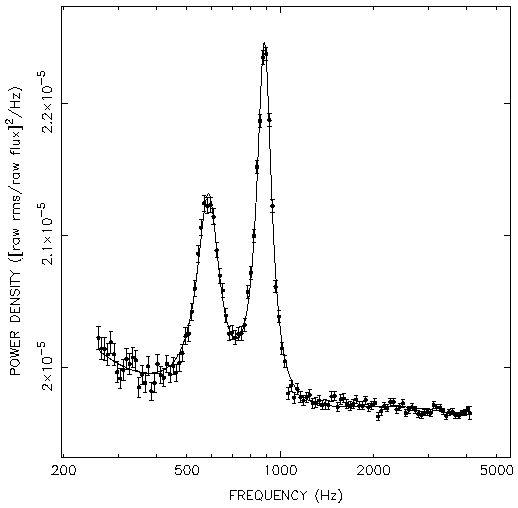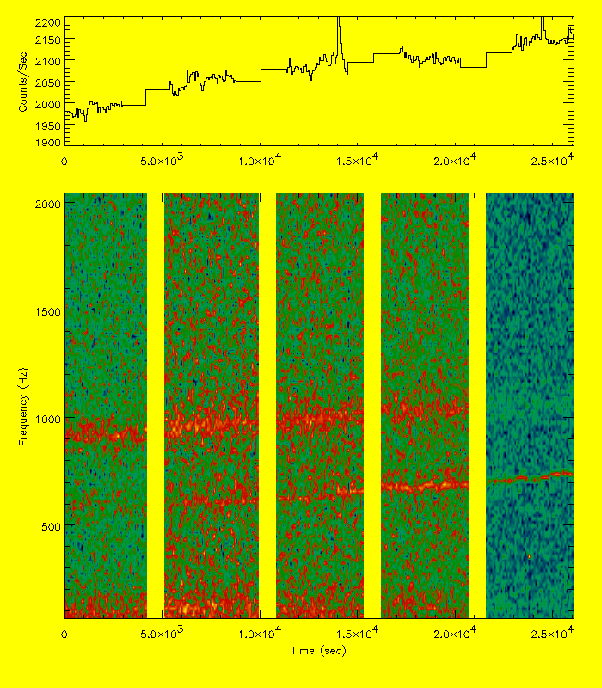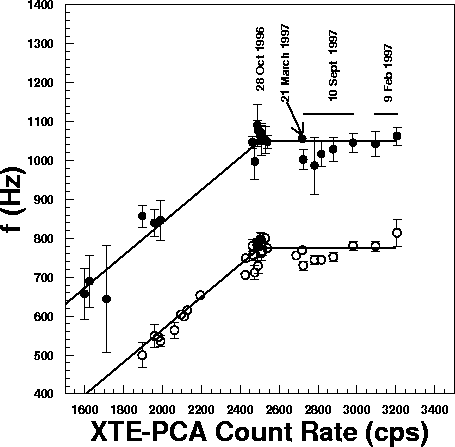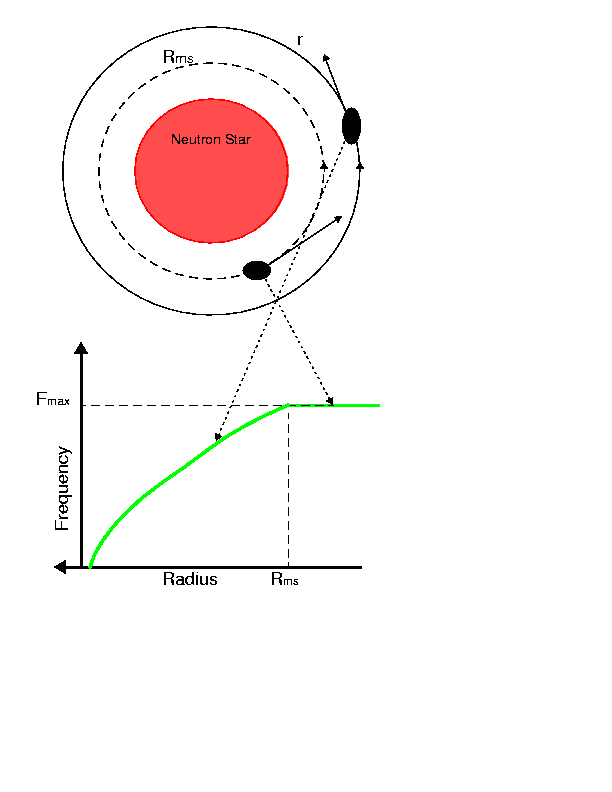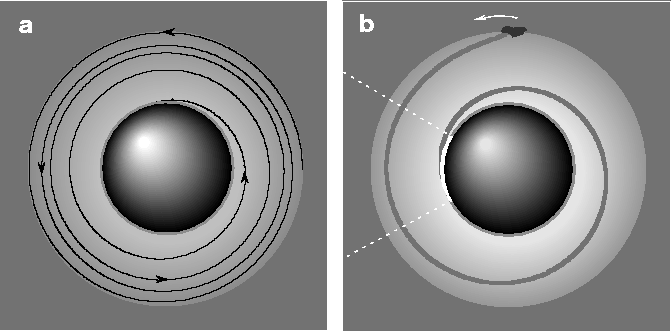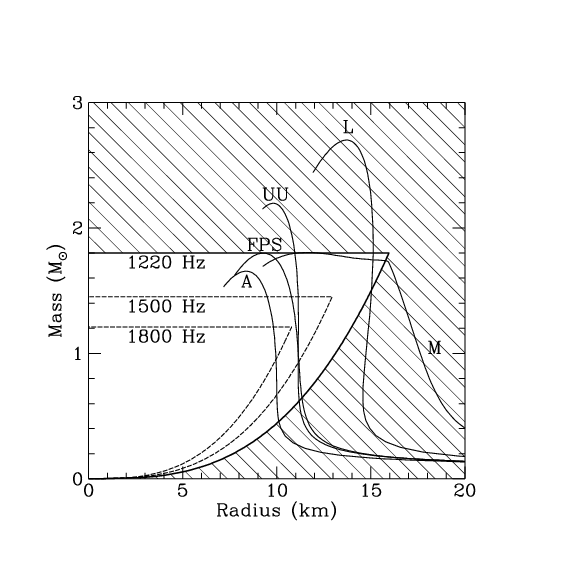The fastest periodic signals seen to date in astronomy have been observed by RXTE in accreting neutron stars. In February 1996, two groups analyzing data at Goddard Space Flight Center began to see evidence for these ultrafast variations in the X-ray light curves of 4U 1728-34 (led by Tod Strohmayer of Goddard) and Sco X-1 (led by Michiel van der Klis of the University of Amsterdam). The oscillations they observed are nearly periodic and have frequencies of about 1000 hertz - hence the name "kilohertz (kHz) quasi-periodic oscillations (QPO)". To date these signals have been seen in about 15 neutron stars in the galaxy. Figure 1 shows a power spectrum of Sco X-1 in which the relative amplitude of oscillation as a function of frequency is plotted. One can see two tiny peaks near 1000 Hz which represent the kHz QPO. They are dwarfed by the much larger peak near 6 Hz showing the usual QPO which has been known and studied in many systems for over 10 years. Since the amount of power associated with an oscillation varies as the frequency times the amplitude of the power spectrum at that point, there is far more "power" in the kHz QPO than the normal QPO. Figure 2 shows an expanded view of the high frequencies. In many of the sources one sees two frequencies which vary with flux - the exact relationship is different for different objects. For some of the sources the difference between the frequencies remains constant, and is thought to be telling us the rotation rate of the neutron star. The rotation rates seen so far are all between about 250 and 350 hertz (i.e., rotations per second). Figure 3 shows a dynamic power spectrum of 4U1728-34 in which the frequency of the two kHz QPO features is shown as a function of X-ray flux. The difference is nearly constant at 363 Hz. Will Zhang at Goddard and collaborators have followed the variations of two frequencies in the ultra-compact binary system 4U 1820-30 and found that above a certain flux level, the frequencies saturate to a maximum (Figure 4). The current understanding of this saturation is that we are seeing the ``innermost stable circular orbit'' (ISCO) around the neutron star, a radius predicted by general relativity inside of which matter must inexorably spiral down to smaller radii (Figure 5). The kHz QPO are the most important scientific result to date of RXTE, and fully utilize the high timing capability of the satellite. The most developed model to account for kHz QPO is the "sonic point model" of Cole Miller, Fred Lamb, and Dimitrios Psaltis. The model follows the detailed trajectories of blobs of gas leaving the inner edge of the accretion disk around a neutron star and spiraling down to the neutron star surface, taking into account the effects of general relativity (Figure 6). The gas spirals inward supersonically and collides with the surface of the neutron star. These authors utilize observations of the highest frequency kHz QPO to place constraints on the allowed "equation of state" for neutron stars. This relationship between pressure and density for a gas made up of dense neutrons determines the mass-radius relation for neutron stars (Figure 7). Alternatively, one can constrain the "compactness" of the neutron star by measuring the amplitudes of the periodic oscillations (which give direct evidence for the neutron star spin rates) during thermonuclear bursts. General relativity predicts that signals arising from near the surface of the neutron star should be deflected by the strong gravitational field. The more compact a star is, the more that strongly varying signals are homogenized into smoothly varying signals. This occurs because the light from any localized spot on the surface of the star would be bent considerably, so that the spot might be seen even when it was on the far side of the star from our line of sight. The observed amplitudes of the ~300 Hz oscillations tell us that the lower limit on the radius for a neutron star is about 7.7 kilometers (for an assumed mass of 1.4 solar masses). A neutron star could not be more compact and yet show oscillation amplitudes as large as those seen.
Figure 1: Power Spectrum of RXTE light curve of Sco X-1 from February, 1996.
Figure 2: A detailed view of the kilohertz QPO in Sco X-1.
Figure 3: Dynamic Power Spectrum of RXTE light curve of 4U1728-34.
Figure 4: The kHz QPO frequencies in the compact binary 4U1820-30 versus flux.
Figure 5: A schematic representation of the ISCO.
Figure 6: A schematic view of the "sonic point" model of Miller, Lamb, and Psaltis.
Figure 7: Constraints on the neutron star equation of state from the kHz QPO.
Figures provided by Cole Miller, Tod Strohmayer, Will Zhang, and Michiel van der Klis. Captions and supporting text provided by J. Cannizzo Back to Snazzy Science If you have a question about RXTE, please send email to one of our help desks.
|



